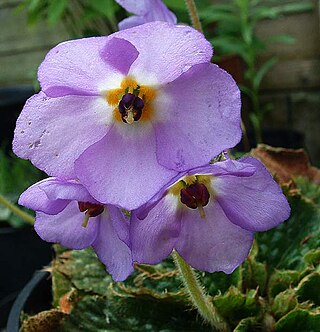
Salvia elegans, a species with several varieties including pineapple sage and tangerine sage, is a perennial shrub native to Mexico.

Cryptobiosis or anabiosis is a metabolic state in extremophilic organisms in response to adverse environmental conditions such as desiccation, freezing, and oxygen deficiency. In the cryptobiotic state, all measurable metabolic processes stop, preventing reproduction, development, and repair. When environmental conditions return to being hospitable, the organism will return to its metabolic state of life as it was prior to cryptobiosis.

A resurrection plant is any poikilohydric plant that can survive extreme dehydration, even over months or years.

Velloziaceae is a family of monocotyledonous flowering plants. The APG II system, of 2003, also recognizes this family, and assigns it to the order Pandanales.

Selaginella lepidophylla, also known as a resurrection plant, is a species of desert plant in the spikemoss family (Selaginellaceae). It is native to the Chihuahuan Desert of the United States and Mexico. S. lepidophylla is renowned for its ability to survive almost complete desiccation. Resurrection plants are vascular rooted plants capable of surviving extreme desiccation, then resuming normal metabolic activity upon rehydration. The plant's hydro-responsive movements are governed by stem moisture content, tissue properties and a graded distribution of lignified cells affecting concentric stem stiffness and spiraling. During dry weather in its native habitat, its stems curl into a tight ball, uncurling only when exposed to moisture.

Ramonda serbica, also known as Serbian ramonda and Serbian phoenix flower, is a species in the family Gesneriaceae and are one of the four plants in the Ramonda genus. It was first discovered in 1874 near Niš, Serbia, by the Serbian botanist Josif Pančić. The Serbian ramonda is notable for its distinctive desiccation tolerance.

Aeschynomene is a genus of flowering plants in the family Fabaceae, and was recently assigned to the informal monophyletic Dalbergia clade of the Dalbergieae. They are known commonly as jointvetches. They range across tropical and subtropical regions of the Americas, sub-Saharan Africa, south, southeast, and east Asia, and Australia. These legumes are most common in warm regions and many species are aquatic.

Cistus salviifolius, common names sage-leaved rock-rose, salvia cistus or Gallipoli rose, is a shrub of the family Cistaceae.

Brodiaea elegans is a species of flowering plant in the cluster-lily genus known by the common names harvest brodiaea, elegant brodiaea, and elegant cluster-lily.

Calochortus elegans is a species of flowering plant in the lily family known by the common name elegant Mariposa lily, cat's ear, elegant cat's ears or star tulip. It is native to the western United States from northern California to Montana.

Echeveria elegans, the Mexican snow ball, God's Throne, Mexican gem or white Mexican rose is a species of flowering plant in the family Crassulaceae, native to semi-desert habitats in Mexico.

Cyclamen coum, the eastern sowbread, is a species of flowering plant in the family Primulaceae. It is a tuberous herbaceous perennial, growing to 5–8 cm (2–3 in), with rounded heart-shaped leaves and pink shell-shaped flowers with darker coloration at the base. It is valued in horticulture as groundcover, and for the flowers which bloom in winter and early spring.

Crassula elegans, the elegant crassula, is a flowering plant species in the genus Crassula.

Myrothamnus flabellifolius is a species of flowering plant in the family Myrothamnaceae native to central and southern Africa. It is also called the resurrection plant for the appearance of dead leaves reviving during rain.

Xerophyta retinervis is a deciduous perennial up to 2 metres tall with stout, erect stems, densely covered in persistent, fibrous leaf bases, often charred and blackened by veldfires. Fragrant flowers appear after fire or rain, and are blue or mauve, or rarely white. The small capsules are covered in rough hairs and are loculicidally dehiscent, releasing numerous small, black angled seeds about 2 mm long. The species is tolerant of extreme conditions such as drought, fire, and low temperatures. The old leaf bases are arranged so that rainwater is funnelled down and to the core, where it is absorbed by densely packed roots that run the entire length of the stem. Strap-shaped leaves occur in tufts along stems.

Cattleya × elegans is a hybrid orchid in the subtribe Laeliinae. It is a pseudobulb epiphyte. Its formula hybridae is Cattleya purpurata Van den Berg (2008) × Cattleya tigrina A.Rich. (1848). It is found in South and South-East Brazil.

Chuniophoeniceae is a tribe of palms in subfamily Coryphoideae of plant family Arecaceae. The four genera within the tribe are morphologically dissimilar and do not have overlapping distributions. Three of the genera are monotypic, while the fourth genus (Chuniophoenix) has three species.

Bryum elegans is a species of mosses in the family Bryaceae. It is found in Norway, Poland, and the Russian Federation.

Bessera elegans, also known by the common name coral drops, is a cormous herbaceous perennial flowering plant in the family Asparagaceae, from Mexico.

Polytrichastrum formosum, commonly known as the bank haircap moss, is a species of moss belonging to the family Polytrichaceae.



















